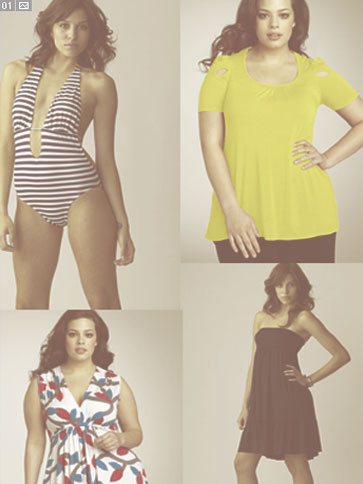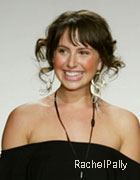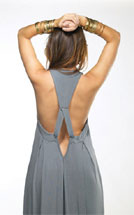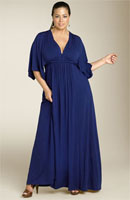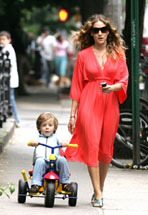|
Rachel Pally – Designing for All Shapes and Sizes
I remember that first collection. It was my very first time at Fashion Week, and I have to be honest, I expected stick figures in ‘unwearable’ garments to be walking down Rachel Pally’s catwalk. But to my delight, I saw clothes that even I could wear. Her collection was a women’s contemporary line, which utilized draping made from jersey to create sensual and beautiful tops, pants, dresses, and skirts. Ever since that day, I have been a die-hard fan of Rachel Pally’s designs. Imagine my sheer delight I’ve seen your work for quite a few seasons, and of course, I am a woman with curves. So your line really does appeal to me. How do you get inspired?
When did you get started? I started my business after college. I graduated in 2002 from Berkley, and I made a set of samples, carried them around, and found a new PR firm that was just starting and was able to take me on for next to nothing. Has your family been very supportive of your designing? My family has been very supportive. Nobody’s actually involved with the business, What caught my eye about your clothes, in particular, is that they are very figure-flattering for women of all figure-types. What made you decide to design for that particular type of body as opposed to…? The tiny contemporary shopper? Exactly. I make sure that in every season I have something for everybody. In fact, I [not too long ago] launched a plus-size line that is exclusive to Nordstrom. So saying that I was able to dress everybody in the contemporary market [isn’t true]. In fact, I was not able to dress everybody. So, I added the second division in order to make sure that I can dress a larger woman as well as 0-12. To me that’s super important. I feel there are a lot of lines out there that don’t cater to everybody and there are plenty of women out there who would love to find great fashions to make them look fantastic. Have there been any challenges in creating designs for plus size?
I really think it’s great. Like for instance with the Dove Campaign…
…And Tyra Banks having this whole backlash for those [unflattering] photographs, I think it is. We have to be realistic about what women look like, and how there’s no reason why women can’t find gorgeous clothes to wear that make them look great. There’s no reason a size 12 or size 16 or size 24 woman can’t look fantastic in her clothes. It’s nice to give that option to people. There isn’t another option. It doesn’t really exist in the market. In creating your designs, was there any one particular body type that you felt was more challenging? It’s definitely harder to fit the plus-size groups because women carry their weight in such different ways. But no, I work with jersey. It’s stretchy and you kind of make do. And not every piece is going to look good on everybody. But everybody in my office tries every piece on when we go through our sample fittings. We all have very different bodies, so it’s very important that everything looks at least good on everybody. It may not necessarily be the individual pieces we may want to purchase for ourselves, but it’s important to see that it works. Since I work with such a
So jersey is your main choice of fabric then? Yes. We’ve done other fabrications, including a cashmere line, accented pieces with satin, we did a fur holiday group, and there will be some changes. We will continue to add new elements, but for the most part it’s just jersey.
How well is the plus line that you launched with Nordstrom doing? So far we’ve done very well. It’s selling online at Nordstrom.com. We’ve gotten a great amount of feedback. But it’s going to take a little while because it’s a brand new idea for that market. It’s not just another cute line that is available in the What are your price points? The price points are about $150 for tops and about $250 for dresses. And it might be a little higher than that because it’s a little pricier than our regular contemporary line. Highest High
That’s a huge high!
Lowest Low
(Laughs) My lowest low was getting myself through reports today at Macy’s on the East Coast! It’s business, and there are times when there are lows. But it’s never been anything that you can’t recover from, luckily for me, at this point of my career. I just keep making it happen. I can’t get discouraged and you just keep pushing it through. The lows are very fleeting. The highs are very exciting. As a successful fashion designer, what advice would you offer to someone who’s up and coming and trying to also achieve the same success? I always feel like I give the same advice. If you are interested in becoming a designer and having your own business, go to college. No need to start and stop with design school. There are a lot of things you can learn along the way, but you have to have your brain trained to solve problems, act fast, and think quickly. That to me has been my biggest asset. I did go to school and I did work really hard and I trained my brain to be fast. I think that that has really helped me more than a design class. There are amazing designers who came out of design school, but for me and the path that I took, my education was the most important thing. What was your major in college? I did city planning, cultural geography, and dance. And I did very random things to have ended up in this industry. But at the same time, thinking is thinking. Do you think that because of the complex major that you had, this is why you’re able to think outside of the box and dress for all types of women as opposed to your standard? Having a dance background is the reason that I can dress for all types of women. I understand the body and I understand the way people move and I understand where things should fall and how things should drape—all based on costumes and based on movement. I’m sure some of it has to do with the diversity in my interests over the years. But I look at my collection and I think, “Wow, I was so clearly a dancer.” There are things in my wardrobe that look like things that I had to wear as costumes, and things that I would have loved to have worn, instead of other things. I feel like that’s where the roots are for sure. What’s next for Rachel Pally? I am just trying to continue to evolve and keep the line exciting. There’s a lot of competition in the jersey market. It’s nice to continue to offer exciting prints or exciting trims or different types of belts, accessories, and to make sure that we stay a step ahead of our game so that we can keep it fresh and keep our buyers excited. hel Pally, visit her website at www.rachelpally.com, and to purchase items from Rachel Pally’s plus-size line, visit Nordstrom’s stores or Nordstrom online. By Kaylene Peoples |
